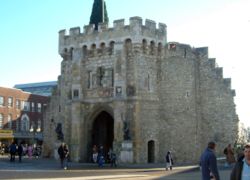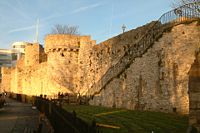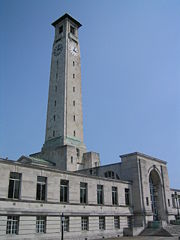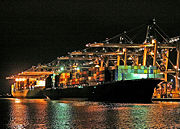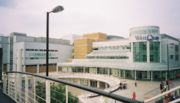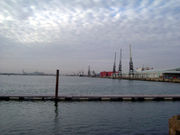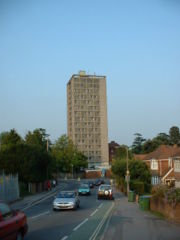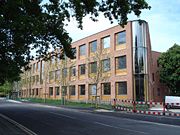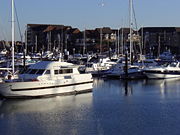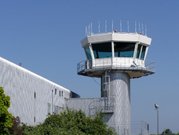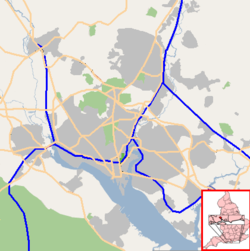Southampton
2008/9 Schools Wikipedia Selection. Related subjects: British Cities; Great Britain
| City of Southampton | |
| The Bargate, Southampton | |
| Southampton shown within England | |
| Sovereign state | United Kingdom |
|---|---|
| Constituent country | England |
| Region | South East England |
| Ceremonial county | Hampshire |
| Admin HQ | Southampton |
| Settled | Circa AD43 |
| City Status | 1964 |
| Unitary Authority | 1997 |
| Government | |
| - Type | Unitary authority, City |
| - Governing body | Southampton City Council |
| - Leadership | Leader & Cabinet |
| - Executive | Conservative |
| - MPs | John Denham (L) Sandra Gidley (LD) Alan Whitehead (L) |
| Area | |
| - Unitary & City | 19.9 sq mi (51.47 km²) |
| Population (2007 est) | |
| - Unitary & City | 228,600 ( Ranked 48) |
| - Density | 11,535.8/sq mi (4,454/km²) |
| - Urban | 304,400 ( Southampton Urban Area) |
| - Metro | 1,000,000 |
| - County | 1,691,000 (Hampshire) |
| - Ethnicity ( United Kingdom 2005 Estimate) |
89.4% White 4.6% S. Asian 1.8% Black. 2.5% Chinese or other 1.8% Mixed Race |
| Time zone | Greenwich Mean Time ( UTC+0) |
| - Summer ( DST) | British Summer Time ( UTC+1) |
| Postcode span | SO14-SO19 |
| Area code(s) | 023 |
| Grid Ref. | SU 42 11 |
| ONS code | 00MS |
| Website: www.southampton.gov.uk/ | |
Southampton ( pronunciation ; IPA /ˌsaʊθˈhæmptən/) is the largest city on the south coast of England.
It is in the county of Hampshire and is a major port and the closest city to the New Forest. The city lies roughly in the centre of the coast, at the northern-most point of Southampton Water where it is joined by the River Test and River Itchen, with the River Hamble joining to the south of the urban area.
The local authority is Southampton City Council, which is a unitary authority. The city is part of the ceremonial county of Hampshire.
Significant employers in Southampton include the University of Southampton, the Ford Transit factory and one of the largest commercial ports in Europe.
The city represents the core of the Greater Southampton region, with a population of 228,600. The city's name is sometimes abbreviated in writing to "So'ton" or "Soton", and a resident of Southampton is called a Sotonian.
Southampton is noted for being the home of the RMS Titanic, the Spitfire and more recently a number of the largest cruise liners in the world.
History
Archaeological finds suggest there have been settlements on the present site of Southampton since the stone age. The Romans established a settlement known as Clausentum, shortly after their invasion of Britain in AD 43. It was an important trading port, at the site of modern Bitterne Manor. The Romans abandoned this settlement circa 410
The Anglo-Saxons formed a new, larger, settlement across the Itchen centred around what is now the St Mary's area of the city. The settlement was known as Hamwic, which evolved into Hamtun and then Hampton.. Archeological excavations of this site have uncovered one of the best collections of Saxon artifacts in Europe.
Viking raids from 840 onwards contributed to the decline of Hamwic in the 9th century, and by the 10th century, a fortified settlement, which became Medieval Southampton had been established.
Following the Norman Conquest in 1066, Southampton became the major port of transit between the then capital of England, Winchester, and Normandy. Southampton Castle was built in the 12th century and by the 13th century, Southampton had become a leading port, particularly involved in the trade of French Wine in exchange for English cloth and wool..
Surviving remains of 12th Century merchants houses such as King Johns House and Canutes Palace are evidence of the wealth that existed in the town at this time. In 1348, the Black Death reached England via merchant vessels calling at Southampton.
The town was sacked in 1338 by the French, including the pirate Grimaldi, who used the plunder to help found the principality of Monaco. After this attack, the city's walls - part of which dates from 1175 - were extensively added to and reinforced. A large part of the town's walls remain today.
The city walls include God's House Tower, built in 1417, the first purpose-built artillery fortification in England. Over the years it has been used as home to the city's gunner, the Town Gaol and even as storage for the Southampton Harbour Board. Today, it is open as the Museum of Archaeology. The walls were finally completed in the 15th century, but later development of several new fortifications along Southampton Water and the Solent by Henry VIII, meant that Southampton was no longer dependent upon its fortifications.
In 1642, during the English Civil War, a Parliamentary garrison moved into Southampton. The Royalists advanced as far as Redbridge in March 1644 but were prevented from taking the town.
During the Middle Ages, shipbuilding became an important industry for the town. Henry V famous warship Grace Dieu was built in Southampton. Walter Taylors 18th century mechanisation of the block-making process was a significant step in the Industrial Revolution. From 1904 to 2004, the Thornycroft shipbuilding yard was a major employer in Southampton, building and repairing many ships used in the two World Wars.
Prior to King Henry V of England's departure for the Battle of Agincourt in 1415, the ringleaders of the " Southampton Plot" - Richard, Earl of Cambridge, Henry Scrope, 3rd Baron Scrope of Masham and Sir Thomas Grey of Heton were accused of high treason and tried at what is now the Red Lion public house in the High Street. They were found guilty and summarily executed outside the Bargate.
Southampton has often been used for Military Embarkation, also fulfilling that role during 18th Century wars with the French, the Crimean war, Boer War. Southampton was designated No. 1 Military Embarkation port during the Great War and became a major centre for treating the returning wounded and POWs. It was also central to the preparations for the Invasion of Europe in 1944.
Southampton became a Spa Town in 1740. It had also become a popular site for sea bathing by the 1760s , despite the lack of a good quality beach. Innovative buildings specifically for this purpose were built at West Quay, with baths that were filled and emptied by the flow of the tide.
The town experienced major expansion during the Victorian era. The Southampton Docks company had been formed in 1835. In October 1838 the foundation stone of the docks was laid and the first dock opened in 1842. The structural and economic development of docks continued for the next few decades. The railway link to London was fully opened in May 1840. Southampton subsequently became known as The Gateway to the Empire.
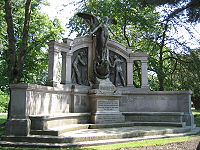
The port was the original point of departure for the Pilgrim Fathers aboard the Mayflower in 1620. In 1912 the RMS Titanic sailed from Southampton. Many of the crew on-board the vessel were Sotonians, with about a third of those who perished in the tragedy hailing from the city. Southampton was subsequently the home port for the transatlantic passenger services operated by Cunard and their Blue Riband liner RMS Queen Mary and her sister ship RMS Queen Elizabeth. In 1938, Southampton docks also became home to the Flying boats of Imperial Airways. Southampton Container Terminals first opened in 1968 and has continued to expand.
The Supermarine Spitfire was designed and developed in Southampton, evolving from the Schneider trophy winning seaplanes of the 1920s and 30's. Heavy bombing of the factory in September 1940 destroyed the factory and many homes in the vicinity, killing many civilians and workers. World War II hit Southampton particularly hard because of its strategic importance as a major commercial port and industrial area. Prior to the Invasion of Europe, many components for Mulberry Harbour were built here. After D-Day, Southampton docks handled a large amount of military cargo to help keep the Allied forces supplied, making it a key target of Luftwaffe bombing raids until late 1944..
Pockets of Georgian architecture survived the war, but much of the city was levelled, there has been extensive redevelopment since World-War II. Increasing Traffic congestion in the 1920s led to partial demolition of medieval walls around the Bargate in 1932 and 1938. However a large portion of those walls remain standing today, leaving Southampton with one of the longest surviving remnants of medieveal walls in the country.
A Royal Charter in 1952 upgraded University College at Highfield to the University of Southampton. Southampton acquired, city status becoming the City of Southampton in 1964.
Government
Southampton used to be a County Borough within the county of Hampshire, which in the past was known as the County of Southampton or Southamptonshire. This was officially changed to Hampshire in 1959 although the county had been commonly known as Hampshire or Hantscire for centuries. Southampton became a non-metropolitan district in 1974. However, the city became independent administratively from that county as it was made into a unitary authority in a local government re-organisation on 1 April 1997 - a result of the 1992 Local Government Act. The district remains part of the Hampshire ceremonial county.
Southampton City Council consists of 48 councillors elected by thirds. After the 2007 local council elections on 3 May 2007 the Council was split with 18 seats each to the Labour and the Conservative Party, each having gained two, and 12 to the Liberal Democrats. The Conservatives took control in May 2007, after a Liberal Democrat resigned from her group to become an independent and voted for the Conservative leader Alec Samuels. During the budget setting meeting on 20 February 2008, a no confidence motion was passed and Labour and the Liberal Democrats formed a coalition.
In the local elections on 1 May 2008, the Conservatives took overall control of Southampton, winning 15 of the 17 seats being contested. Both the Labour and Liberal Democrat leaders lost their seats to young Conservative challengers.
As of 2008 this is how Southampton city council stands.
| Year | Conservatives | Labour | Liberal Democrats |
|---|---|---|---|
| 2008 | 26 | 14 | 8 |
There are three members of parliament for the city: Rt Hon John Denham (Labour) for Southampton Itchen, the constituency for the east of the city, Dr Alan Whitehead (Labour) for Southampton Test which covers the west of the city, and Sandra Gidley (Liberal Democrat) for Romsey, which includes a northern portion of the city. The Boundary Commission for England has created the new constituency of Romsey and Southampton North, by enlarging the current Romsey one. The new boundaries encompass the unitary authority wards of Bassett and Swaythling. It will be in place in time for the 2009 or 2010 General Election.
Southampton's police service is provided by Hampshire Constabulary, its fire service by Hampshire Fire and Rescue Service and the ambulance service by the South Central Ambulance Service. Police stations within the city boundaries can be found in Portswood, Bitterne, and Shirley, as well as at the Civic Centre in the city centre. Fire stations are located in St Mary's, Sholing and Redbridge.
Geography and climate
The geography of Southampton is very much influenced by the sea and rivers. The city sits at the northern tip of the Southampton Water, a deepwater estuary, which is a ria formed at the end of the last Ice Age. Here, the rivers Test and Itchen converge. The Test - which has saltmarsh that make it ideal for Salmon fishing - runs along the Western edge of the city, while the Itchen splits Southampton in two - east and west. The city centre is located on the peninsula between the two rivers.
Much of the Waterfront has been reclaimed over the years, mainly for use as the Western Docks. Most of the land used for reclamation came from dredging of Southampton Water, to ensure that the port can continue to handle some of the largest ships in the world. The shape of the coastline gives rise to a natural phenomena in Southampton, known as the double tide. This gives the port a much longer high tide period than other ports, making the movement of large ships easier.
The city itself lies in the Hampshire Basin, which sits atop large amounts of chalk beds.
| Weather averages for Southampton, England, UK | |||||||||||||
|---|---|---|---|---|---|---|---|---|---|---|---|---|---|
| Month | Jan | Feb | Mar | Apr | May | Jun | Jul | Aug | Sep | Oct | Nov | Dec | |
| Average high °C (°F) | 8 (46) | 8 (46) | 10 (50) | 13 (55) | 16 (61) | 19 (67) | 22 (71) | 21 (70) | 19 (66) | 15 (59) | 11 (51) | 9 (48) | |
| Average low °C (°F) | 1 (34) | 1 (34) | 2 (36) | 3 (38) | 7 (44) | 9 (49) | 11 (52) | 11 (52) | 9 (48) | 7 (44) | 3 (38) | 2 (35) | |
| Precipitation mm (inches) | 88.9 (3.50) | 61 (2.40) | 66 (2.60) | 48.3 (1.90) | 55.9 (2.20) | 53.3 (2.10) | 40.6 (1.60) | 55.9 (2.20) | 66 (2.60) | 78.7 (3.10) | 83.8 (3.30) | 88.9 (3.50) | |
| Source: Weather.com 2007-08-03 | |||||||||||||
Demographics
As is the case with most large towns in the UK, Southampton has a diverse range of cultures and ethnic groups, which make up the estimated 228,600 people living within the city boundary. There is a large Polish population in the city, with estimates as high as 20,000, or 1 in every 10 of the total population. Southampton also has large Asian and Irish communities. At the 2001 Census, 92.4 per cent of the city's populace were white – including one per cent white Irish – 3.8 per cent were South Asian, 1.0 per cent Black, 1.3 per cent Chinese or other ethnic groups, and 1.5 per cent were of mixed race.
In total, there are 112,400 males within the city and 109,500 females. The 20-24 age range is the most populous, with an estimated 28,100 people falling in this age range. Next largest is the 25-29 range with 20,500 people and then 30-34 years with 17,000. By population, Southampton is the largest monocentric city in the South East England region and the second largest on the South Coast after Plymouth.
Between 1996 and 2004, the population of the city increased by 4.9 per cent - the tenth biggest increase in England. In 2005 the Government Statistics stated that Southampton was the third most densely populated city in the country after London and Portsmouth respectively. Hampshire County Council expects the city's population to grow by around a further two per cent between 2006 and 2013, adding around another 4,200 to the total number of residents. The highest increases are expected among the elderly.
Economy
There are currently 120,305 jobs in Southampton, and 3,570 people claiming job seekers allowance, approximately 2.4 per cent of the city's population, as of March 2007. This compares with an average of 2.5 per cent for England as a whole.
As of June 2006, 74.7 per cent of the city's population are classed as economically active.
Just over a quarter of the jobs available in the city are in the health and education sector. A further 19 per cent are property and other business and the third largest sector is wholesale and retail, which accounts for 16.2 percent. Between 1995 and 2004, the number of jobs in Southampton has increased by 18.5 per cent.
As of January 2007, the average annual salary in the city was £22,267. This was £1,700 lower than the national average and £3,800 less than the average for the South East.
Southampton has always been strongly connected with maritime history and developments, and the docks have long been a major employer in the city. In particular, it is a primary port for cruise ships, its heyday being the first half of the 20th century, and in particular the inter-war years, when it handled almost half the passenger traffic of the UK. Today it remains home to many luxury liners, as well as being the largest freight port on the Channel coast, with several container terminals. Unlike many other ports, such as Liverpool, London, and Bristol, where industry and docks have largely moved out of the city centres leaving room for redevelopment, Southampton retains much of its inner-city industry. Part of the docks have been redeveloped, however, as the Ocean Village development, a local marina and entertainment complex. Southampton is home to the headquarters of both the Maritime and Coastguard Agency and of the Marine Accident Investigation Branch of the Department for Transport.
During the latter half of the 20th century, a more diverse range of industry also came to the city, including aircraft and automobile manufacture, cables, electrical-engineering products, and petrochemicals. These now sit alongside the city's traditional industries of the docks, grain milling, and tobacco processing.
Southampton University Hospitals NHS Trust is one of the city's largest employers. It provides local hospital services to half a million people in the Southampton area and specialist regional services to more than three million people across the South of England. The Trust owns and manages Southampton General Hospital, the Princess Anne Hospital and a palliative care service at Countess Mountbatten House.
Other major employers in the city include Ordnance Survey, the UK's national mapping agency, whose headquarters are in the city. The Lloyd's Register Group has announced plans to move its London marine operations to a specially developed site at the University of Southampton. The area of Swaythling is home to Ford's Southampton Assembly Plant, where the majority of their Transit models are manufactured.
Southampton's largest retail centre is the West Quay Shopping Centre. Opened in September 2000 and hosting major High Street brands it is one of the largest in the country. The centre itself was phase two of the West Quay development. The first was the West Quay Retail park, while the third phase has been planned for a number of years with the latest target of work starting being 2007. The plans include building more shops, housing, offices including the headquarters for Carnival Cruises and additional leisure facilities. A decision as to what leisure facilities is still to be taken, however Southampton has been granted a licence for a large casino.
Swedish low-cost home products retailer IKEA has been given permission to open a store in the city centre near West Quay. Other major shopping areas in the city centre include The Mall Marlands, The Bargate Centre and the East Street area, which has been designated for speciality shopping, with the aim of promoting smaller retailers. Overall, Southampton is ranked 13th for shopping in the UK.
Like many cities in the UK, Southampton's strong economy is promoting redevelopment, and major projects are proposed, including the city's first skyscrapers on the waterfront. The three towers proposed will each stand 23 storeys high and will be surrounded by smaller apartment blocks, office blocks and shops. There are also plans for a 15-storey Hotel at the Ocean Village marina, and a 21-storey hotel on the north eastern corner of the city centre, as part of a £100m development.
Another project would have been the permanent docking of the Queen Elizabeth 2 in Southampton (her home port since 1969) as a floating hotel and tourist attraction when she is retired; however, Cunard Line announced on June 18, 2007, that the ship will be sold to Dubai for those purposes.
Southampton is unique in being the only city in the UK with a geothermal power station. The station provides hot water to a city centre district heating scheme. In a recent survey of carbon emissions in major UK cities conducted by British Gas, Southampton was ranked as being one of the lowest carbon emitting cities in the United Kingdom.
According to figures from 2004, Southampton contributes around £4.2bn to the regional economy annually. The vast majority of this is from the service sector, with the remainder coming from industry in the city. This figure has almost doubled since 1995.
Crime
According to government figures Southampton has a higher crime rate than the national average. In the Violence against the person category, the national average is 16.7 per 1000 population while Southampton is 38.4 per 1000 population and in the Theft from a vehicle category, the national average is 7.6 per 1000 compared to Southampton's 17.4 per 1000. Overall, for every 1,000 people in the city, 102 crimes are recorded.
Education
The city has a strong higher education sector. The University of Southampton and Southampton Solent University together have a student population of almost 40,000.
The University of Southampton - which was founded in 1862 and received its Royal Charter as a university in 1952 - is one of the top 10 research universities in the UK, and has over 22,000 students. It is considered one of the top 80 universities in the world (Times Higher Education World Rankings 2007). It provides a wide range of services for the business community. The university has a global reputation for leading-edge research into oceanography, cancer sciences, sound and vibration research, computer science and electronics, optoelectronics and textile conservation. It is also home to the National Oceanography Centre, Southampton, the focus of Natural Environment Research Council-funded marine research.
Southampton Solent University has 17,000 students and its strengths are in the training, consultancy, research and other services undertaken for business and industry.
Over 40 per cent of school pupils in the city that responded to a survey claimed to have been the victim of bullying. More than 2,000 took part and said that verbal bullying was the most common form, although physical bullying was a close second for boys.
Transport
As befits Southampton's role as a major port, the city has good transport links with the rest of the country. The M27 motorway, linking places along the south coast of England, runs just to the north of the city. The M3 motorway links the city to London and also, by linking to the A34 road at Winchester with the Midlands and North. The M271 motorway is a spur of the M27, linking it with the Western Docks and city centre.
Southampton is also well served by the rail network, which is used by both freight services to and from the docks and passenger services as part of the national rail system. The main station in the city is Southampton Central. Rail routes run east towards Portsmouth, north to Winchester, the Midlands and London, and westwards to destinations such as Salisbury, Bristol, and Bournemouth.
Local train services operate in the central, Southern and Eastern sections of the city, with stations at Swaythling, St Denys, Millbrook, Redbridge, Bitterne, Sholing and Woolston.
Southampton Coach Station, which is located near the West Quay Shopping Centre, was recently refurbished and the range and frequency of services offered by National Express services make use of the new facilities.
Southampton Airport is a regional airport located in the town of Eastleigh, just north of Southampton. It hosts flights to UK and near European destinations, and is connected to the city by a frequent rail service from Southampton Airport (Parkway) railway station, and a number of bus services.
Whilst Southampton is no longer the base for any cross-channel ferries, it is the terminus for three internal ferry services, all of which operate from terminals at Town Quay. Two of these, a car ferry service and a fast catamaran passenger ferry service, provide links to East Cowes and Cowes respectively on the Isle of Wight and are operated by Red Funnel. The third ferry is the Hythe Ferry, providing a passenger service to Hythe on the other side of Southampton Water.
Buses now provide the majority of local public transport, with significant peak hour congestion in the city. The main bus operators are First Southampton, Uni-link and Bluestar. Other operators include Brijan Tours, Velvet, Stagecoach and Wilts and Dorset. Free buses are provided by City-link and City Loop. City-link runs from town quay to Southampton Central Station and is operated by Uni-link. The Uni-link bus service was commissioned by the University of Southampton to provide access to students who are studying at the university to all parts of the city. The buses run from early in the morning to midnight meeting demands of students who wish to get to the city during the day and leisure places in the evening. There is also a door to door minibus service called Southampton Dial a Ride, for residents who cannot access public transport. This is funded by the council and operated by SCA Support Services.
There are two main termini for bus services. As the biggest operator, First uses stops around Pound Tree Road, and occupy a lot of space there. This leaves the other terminal of West Quay available for other operators. Uni-link passes West Quay in both directions, and Wilts and Dorset drop passengers off and pick them up there, terminating at a series of bus stands along the road. Certain Bluestar services also do this, while others stop at Bargate and some loop round West Quay, stopping between Bargate and Pound tree Road. There was a tram system from 1879 to 1949.
Southampton used to be home to a number of ferry services to the continent, with destinations such as San Sebastian, Lisbon, Tangier and Casablanca. A ferry port was built during the 1960s. However a number of these relocated to Portsmouth and by 1996, there were no longer any car ferries operating from Southampton with the exception of services to the Isle of Wight. The land used for Southampton Ferry Port was sold off and a retail and housing development was built on the site. The Princess Alexandra Dock was converted into a Marina. Now the new Ian Harold Brown car reception area fills the Eastern Docks where passengers, dry docks and trains used to be.
Areas and suburbs
Southampton is subdivided into several council wards, suburbs, constituencies, ecclesiastical parishes, and other less formal areas.
Southampton is named the 'Green City' as it is graced with many green spaces and parks. The largest green space is the 148 hectare Southampton Common, parts of which are used to host the annual summer festivals, circuses and fun fairs. The Common includes a wildlife centre on the former site of Southampton Zoo, a swimming pool and several lakes and ponds.
As with most cities there are several council estates such as those in the Weston, Thornhill and Townhill Park districts. Overall, the city is ranked 96th most deprived out of all 354 Local Authorities in England.
During the 2006/07 financial year, 1,267 residential dwellings were built in the city - the highest number for 15 years. Over 94 per cent of these properties were flats.
There are 16 Electoral Wards in Southampton, each consisting of longer-established neighbourhoods (see below).
There are also a number of settlements outside of the city boundaries that are sometimes considered suburbs of Southampton, including Chartwell Green, Chilworth, Nursling, Rownhams, Totton and West End.
|
|||||||||||||||||
Notable people
There have been a number of notable people who either hail from Southampton or who have lived in the city over the years. In the sphere of music, the city is the home of Coldplay drummer, Will Champion, whose father and late mother taught at the university. R&B singer Craig David was brought up on the Holy Rood estate in the city centre, and BBC Radio One DJ Scott Mills comes from the city too. In the past, the city was home to Isaac Watts, a famous hymn writer, who notably composed O God, Our Help in Ages Past which is the school hymn of the King Edward VI school in the city and the peal of the Civic Centre clock tower. In other arts, Sir John Everett Millais, who now has a museum named after him in the city, came from Southampton as did Benny Hill, the internationally renowned comedian, who had a milk round in nearby Eastleigh - the inspiration for his song Ernie (The Fastest Milkman In The West). SKY, & International Radio Presenter Andy Collins and naturalist TV presenter Chris Packham are natives too.
Admiral John Jellicoe, commander of the British fleet at the Battle of Jutland was a Sotonian and Argentinian dictator Juan Manuel de Rosas spent his last years in exile in the city.
Former England and Southampton F.C. footballer Matthew Le Tissier lives in the city, as he has done since the mid-1980s, and Olympic athlete Iwan Thomas lives there as did former tennis player Wally Masur.
Twinning
Southampton is twinned with:
Southampton is also a sister city of:
 Hampton, Virginia
Hampton, Virginia Qingdao, China (since 1998)
Qingdao, China (since 1998)
